Daniel
Introduction
Daniel was a young man when he was taken into exile in Babylon with the people of Judah, before the group that would include Ezekiel. Many have tried to push the date of writing past the events predicted, out of nothing but bias against divine inspiration, because the prophecies concerning historical events are so accurate and detailed. Jesus referred to Daniel specifically, as also did Ezekiel.
Daniel 1
The book of Daniel begins with historical context, that being his deportation to Babylon by King Nebuchadnezzar. But the king knew the value of people of character and intelligence, so he had his official search for standouts among the captives. These were to be treated well, fed from the king’s table, and educated in the literature and language of Babylon. Some today would consider accepting such an offer an act of betrayal, but this is short-sighted; most rebellions require infiltrators in high places. However, in this case, it was God’s long-range plan to bring a remnant back from exile. So always seek God’s will if you find yourself— or are tempted to bash someone else— in a similar situation.
It turns out that Daniel and three of his friends were among the chosen, and all of them were given Babylonian names. It’s curious that tradition has always referred to Daniel by his Hebrew name, while his friends are called by their Babylonian names. Now in verse 8 it says that Daniel didn’t want to be defiled by the king’s food, so he asked to be fed a vegetarian diet. Some take this as a divine mandate for vegetarianism, but it’s nothing of the sort; it was a choice to eat only that which was permitted by the law of Moses, in a foreign land where the meat did not qualify. The law allowed and even presumed the eating of clean meats.
Because of this brave stance, God blessed Daniel and his friends with great knowledge and skill, but Daniel was also given prophetic insight. So after the three-year training period, these four people impressed the king more than all the others, and Daniel himself would live through the entire span of the neo-Babylonian empire, as shown in verse 21.
Daniel 2
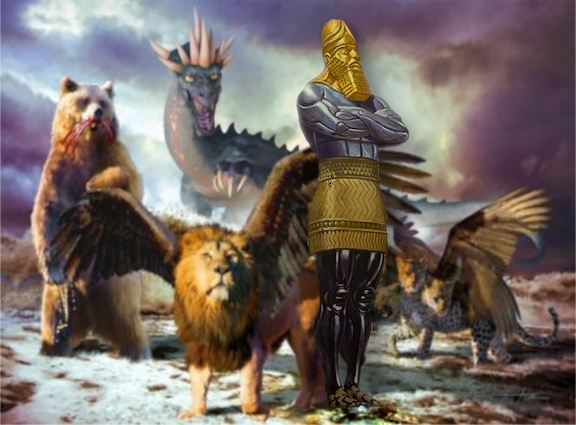
Now begins the king’s experiences of many strange dreams. But he doesn’t remember a particular one, and he demands that his astrologers tell him both the dream and its meaning. After they become exasperated with the threat of a horrible death because they have no real psychic ability, we see in verse 10 that they and all the other wise men
, including Daniel and his friends, were to be rounded up and executed.
But Daniel was granted time to prevent the executions, so he had his friends all pray for God’s mercy and interpretation. Upon receiving it, we see in verse 19 that Daniel praises God, another thing we Christians need to remember. Then in verse 25 he informs the official that he is ready to appear before the king with the answers. And he begins by crediting God with this insight, rather than taking credit for himself— yet another reminder for us Christians.
The dream itself was of a statue made of metals from head to toe in decreasing order of value. The interpretation begins in verse 37 and extends through verse 45. It is a prophecy of four world empires beginning with King Nebuchadnezzar as the head of gold. The next to come, the silver part, would be less powerful, which turned out to be that of Medo-Persia. After that would come the bronze part representing the even less-powerful Grecian Empire, followed by the iron legs representing the least-powerful Roman Empire. The feet of a mixture of iron and clay are not a fifth empire but a description of the fourth in its final stages. It will become weak because it will attempt to force together people groups who aren’t compatible.
Some take the phrase mingling with the seed of men
as meaning hybrid humans or Nephilim. But we should note first of all that the word for men means common, ordinary people as opposed to rulers or elites, and the word for mingling means trading or associating. So it seems the interpretation with the best support is that this represents a mixture of incompatible cultures, governments, and economies, brought about by Rome’s wide-ranging conquest. The present EU is a good example; it was forced into a union that has never really unified except in the power class, who keeps trying to force it on unwilling populations. We also see the desperate attempt to break resistance to it by injecting middle easterners in large numbers, but this too is failing.
Many have also tried to put significance into both the two legs and the ten toes, saying that the legs represent the eastern/western divison of the Catholic Church (Roman and Greek), but then we must ask why a similar argument isn’t made for the statue’s two arms. The passage gives no indication that either the number of arms and legs or the number of toes has any significance. And last but not least, in the days of those kings
the divinely-cut stone, representing the everlasting kingdom of the Messiah, will permanently destroy the Roman Empire in the end times.
When the king realized that Daniel had rightly described and interpreted the dream, he bowed to him and ordered people to make sacrifices to him. But we know he wasn’t being made a god, because the king gave honor to Daniel’s God as the one above all others. However, he was elevated to a very high government position, to which Daniel hired his friends as assistants. But as the saying goes, No good deed goes unpunished
.
Daniel 3
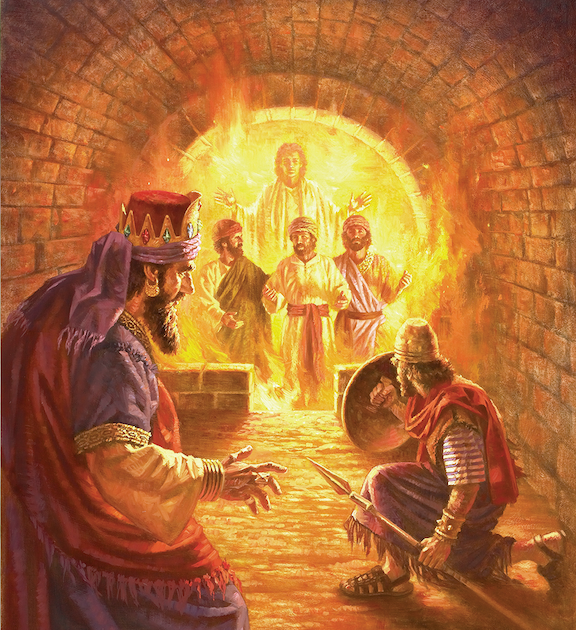
We see here how short-lived such honors can be. The king decides to build a giant statue that everyone would be obligated to worship, on pain of death by being thrown into a furnace. Of course, the formerly demoted astrologers saw the opportunity to be rid of these Hebrew upstarts, so we see in verse 8 that they eagerly expose Daniel’s friends as lawbreakers who refused to worship the statue; there’s no mention of Daniel here but only his friends. So the king, who seemed to have the memory and loyalty of a goldfish, has them arrested and gives them one last chance to comply.
But in verse 16 they issue a challenge of their own: They will gladly be thrown into the furnace, where either they’ll die or they’ll be miraculously delivered, but either way they won’t worship the statue. So the king flies into a blind rage and has the fire stoked to much higher temperatures than normal, then has strong soldiers throw them in. But the only people killed are the soldiers!
Then the king sees four people in the fire, all walking around unharmed and unbound, and the fourth appears to be supernatural. So the king calls them to come out of the furnace, though the supernatural being does not. They’re found to be completely unharmed by the fire, so in verse 28 the king comes to his senses and praises the God who protected them. Further, he orders all of Babylon to honor their God. Does anyone still think these Hebrews were traitors?
Daniel 4
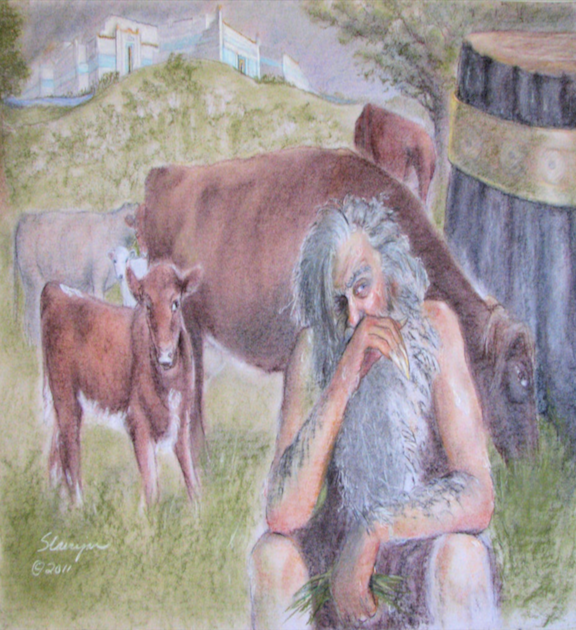
This passage shows the content of the edict from the king about all this, though the first three verses really belong to the end of ch. 3, and that’s how the Greek text has it. What follows is a completely separate incident, another dream. This time he tells his astrologers the dream, but they still can’t interpret it. So once again it’s Daniel to the rescue.
The dream is about a huge tree, which is ordered to be chopped down but its taproot left in the ground, where it would be covered in dew and left with the animals. Then the text turns to the actual meaning and says that his
mind would be turned into that of an animal for seven years, to teach him that God has authority over human kingdoms. But the interpretation in verse 19 shows just how harsh the lesson will be, and it disturbs Daniel to the point where he’s very reluctant to give it.
Daniel tells him that he will be stricken with the mind of an animal and driven from human contact, where he’ll eat grass with the animals and live outside, for the alotted seven years. But like the preserved taproot, the king would get his mind and kingdom back, because he would finally understand that everything he is and has is only by God’s decree and mercy. Notice that in verse 27 Daniel pleads with the king to stop sinning so this doesn’t happen, because the king had been turning a blind eye to the plight of the poor.
But it isn’t until a year later that the seven years of madness began, when the king boasted that everything was due to his own power and skill. As soon as the words left his mouth, a voice from heaven rebuked him and off he went. Now in verse 34 he is quoted as saying that his sanity returned as predicted once the seven years were passed, and the kingdom was restored to him.
Daniel 5
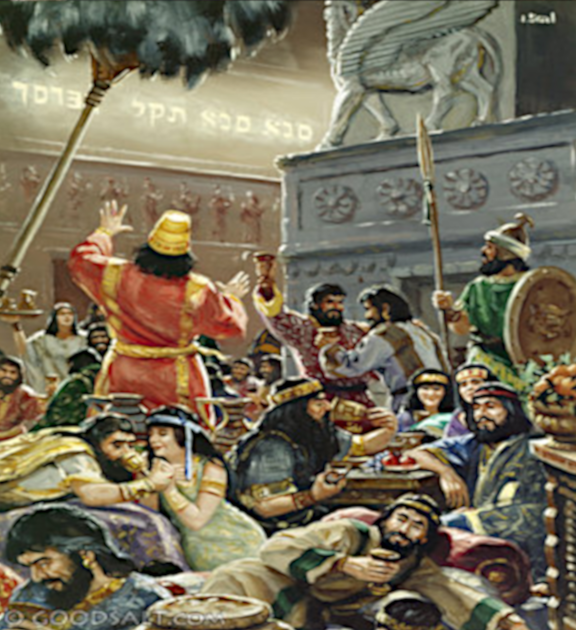
Without any other explanation, the text turns here to the reign of Belshazzar, second in command to someone extra-Biblical texts call Nabonidus. This is why Belshazzar would promise to make someone the third ruler of Babylon, he being the second in command. Check Constable's Notes for more details of names and years passing in all this. But he’s most famous for an expression many don’t realize comes from the Bible: the hand writing on the wall
.
Belshazzar was partying and drunk when he made the grave mistake of having everyone drink wine from the gold and silver cups that had been taken from God’s temple in Jerusalem. They even praised their gods of metal, wood, and stone while they drank. So God let them see something they didn’t expect to see even in that condition: a disembodied hand writing mysterious words on the wall. So the king calls for his astrologers and offers great wealth and honor to whoever could explain this, but of course his astrologers were as useless as all the others before them. Yet even today, people consult astrologers and believe they have scientific
proof that the stars order their lives.
But at least the queen mother had a better memory than a goldfish, and she tells them to send for Daniel. When he arrives, he tells Belshazzar to keep his gifts and honors, because he’ll give the meaning for free. His message is that Belshazzar didn’t learn the lesson taught to Nebuchadnezzar and had no humility or respect for God. So in verse 25 we see that the words on the wall mean that Belshazzar’s days are numbered, that his life is not measuring up, and that the kingdom of Babylon was about to be divided up between the Medes and Persians, as we recall from the vision of the statue. He was killed that very night and replaced by Darius the Mede.
Daniel 6
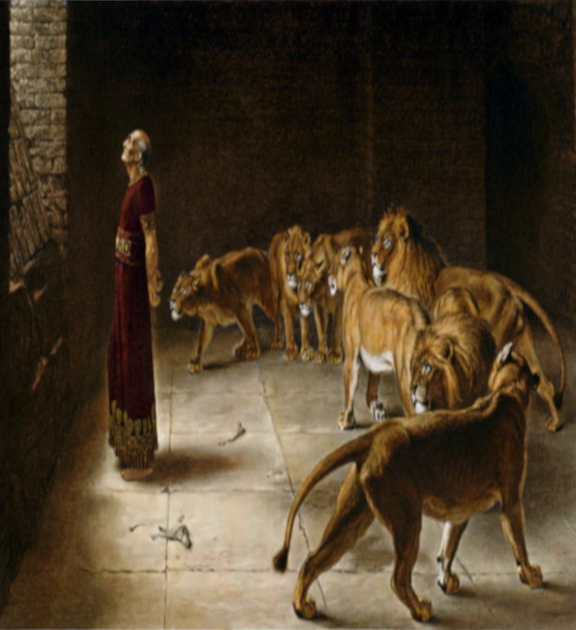
Darius kept Daniel as an advisor, who once again impressed the new king. But as before, the others were jealous of the honors bestowed upon him. Yet because he lived such a clean life that they couldn’t catch him on corruption charges, they hatched a plot to get him executed because of his God. That same tactic is used often today, whenever some pesky, clean-living Christian gets in the way of other people’s plans.
They advise the king to make a permanent and inflexible law: For the next thirty days, whoever worships any god or king but him should be thrown into a den of hungry lions. Daniel hears about it and immediately breaks the law by praying to God as he always had. Of course, the jealous schemers knew his habits and just happened
to catch him in the act. So off they go to snitch to the king, who tries his best to find a legal loophole to get Daniel out of this predicament. But the snitches tell him it’s no use, so the order is given to throw Daniel to the lions.
At least Darius escorts him there, hoping that God would protect him. And this was no mere hole in the ground; it was covered with a heavy stone and sealed off, much the way the temporary tomb of Jesus would be done. After a sleepless night, the king hurries back to the den and calls out to Daniel, who as we can see in verse 21 was unharmed. So he is lifted out of the den, but the king quickly gives another order: to throw in the snitches and their families, who are chewed up before they even hit bottom.
Then Darius sends out a notice to the whole land that only Daniel’s God was to be worshiped. Now we can’t always expect to be rescued for our faithfulness, as we see in Heb. 11, but we do see that in this case it caused many to turn to the one true God. Verse 28 adds that Daniel lived on through the reign of Darius to that of Cyrus the Persian. So ends the primarily historical section of the book, and now it’s back to more detail given in a different way about the vision of the statue.
Daniel 7
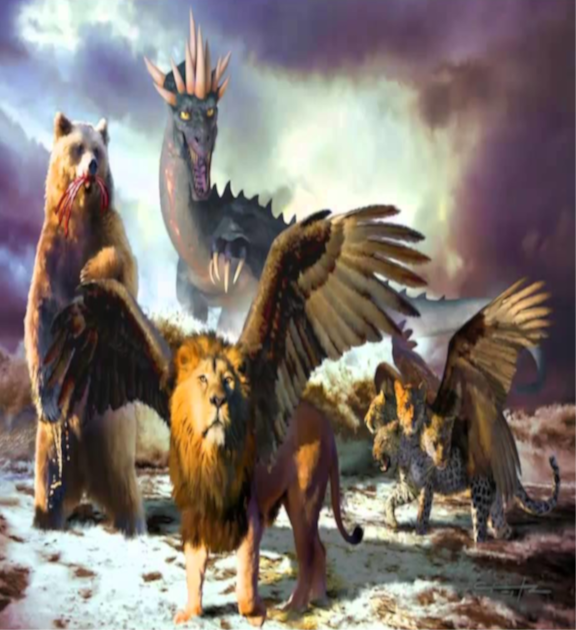
Notice first of all that this vision comes during the reign of Belshazzar rather than Cyrus. Also notice that it is given to Daniel rather than to the king, and that the interpretation is given to Daniel by an angel. You might also want to view the chart in Constable's Notes on this passage, which compares the two visions.
These beasts all come out of the sea, meaning the Gentile nations. The first was something like a winged lion, whose wings were torn off, after which it stood on two legs like a human and was given a human’s mind. The second was like a bear, and it had three ribs in its mouth and was told to go out and devour more. The third was like a leopard having four wings on its back and four heads, and it was given authority to rule.
The fourth was not compared to any known animal, but it was fearsome and powerful, with two rows of iron teeth. It crushed and trampled everyone and everything, and it had ten horns. But as Daniel watched, a small horn grew up among the ten and three other horns were torn out to make room for it. This little horn
had human-like eyes and a boastful mouth. Then in verse 9 Daniel sees the throne of God, and by comparing it to the description in the first chapter of Revelation, we see that this is much like Jesus in his glory before he took on human flesh as stated in Phil. 2:5-11. Notice in verse 10 that the scene is a courtroom, and the books opened should be understood in that context.
Daniel sees that the fourth beast was killed and thrown into the fire, which is described also in Rev. 19:20. Here, the other beasts were allowed to continue ruling for a time and season
. But then in verse 13 Daniel turns his attention to someone described as human-like, who approaches the Ancient One by coming with the clouds
, as referenced in Mat. 24:30 and Rev. 1:7. So both the Father and the Son are described in very similar terms, which shouldn’t surprise us if we understand that Jesus has always been God but also became human at a point in time.
Lest anyone try to guess the meanings, the fact that Daniel is given them means we can’t allegorize them, especially since the animals are the symbols. Again the vision reveals a succession of kingdoms, but Daniel is particularly curious about the fourth one. Notice additional detail in verse 21: The little horn
waged war against the holy ones
and was defeating them, which of course cannot apply to the church, since in Mat. 16:18 Jesus said that could never happen. But the Ancient One prevents their complete annihilation, and the court scene mentioned earlier is to judge in their favor.
The explanation of the fourth kingdom is given in verse 23: It will conquer and subjugate the whole world. Ten kings will rise to power within it, followed by an 11th who topples three of them. He will blaspheme God and relentlessly persecute any who follow him. Then he will attempt to change lawfully-appointed times
, a likely reference to either the Hebrew sacred calendar or to a doomed effort to thwart the prophecies of God. The phrase a time, times, and half a time
throughout Daniel is held by pretty much everyone to mean 3-1/2 years, and we’ll see more about this in ch. 9. But that’s the length of the reign of this boastful king, which ends with the heavenly court’s decision to remove him from power and banish him forever.
Now before we end this vision of prophecy, notice more references in Revelation, especially ch. 17. As Constable's Notes points out, Daniel and Revelation have similar structures: introduction, worldwide judgments, and focus on Israel. These are some of the many reasons why Revelation is the unsealing
of Daniel’s end-tmes prophecies, and how we know that the judgments of Revelation span seven years. For those who say all of this was fulfilled by the end of the first century a.d., they must appeal to allegory since these things clearly have not happened.
Daniel 8
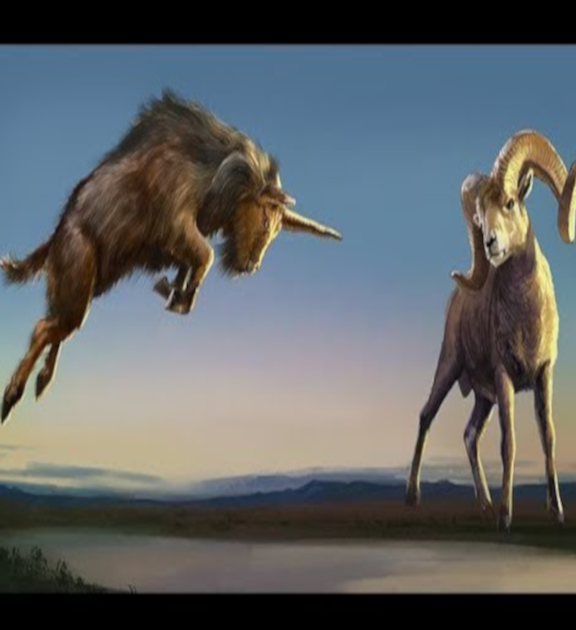
Now we come to the vision about a goat and a ram. The ram’s horns were different lengths, with the longer one growing after the shorter one. The ram was unstoppable in conquest, but then came the goat with a horn between its eyes, flying toward the ram with blinding speed and easily destroying it. The goat, like the little horn, was very arrogant, but its power was short-lived, and the single horn was replaced with four others pointing to the four compass points.
A small horn grew up among them and aimed against the north, south, east, and Israel, the beautiful land
. This same horn is then said to have reached to heaven
and drawn away some of the stars, but it trampled them and then turned against the prince of the army of heaven
, from whom the daily sacrifice was removed and the temple destroyed. Truth itself was also hurled to the ground.
Taking one-third of the stars from heaven and hurling them to earth is mentioned in Rev. 12:4, but what can it mean that they’re trampled? Some say the stars here must refer to the people of Israel, since they had the Temple, but others say that they represent the fallen angels. Yet why would Satan destroy his own angels? A possble answer is that they had been defeated by heaven’s armies according to Rev. 12:7, so Satan destroys them in a fit of rage for their failure. But though we really can’t rule out either interpretation, Constable's Notes considers it beyond dispute that it refers here to the people of Israel because of verse 12. So what we have here may be another type and shadow, the defeat of Israel foreshadowing the defeat of the fallen angels.
Now for interpretations of the ram and goat. The ram seems to represent Medo-Persia, which was also portrayed as the bear and the silver part of the statue in earlier visions, and it had pushed in those directions. The goat seems to represent Greece, especially its unprecedented conquest under the tactical genius of Alexander the Great. This was portrayed in the earlier visions as the leopard and the bronze part of the statue. This all played out in history, more details of which we’ll see later.
Then Daniel hears someone ask the duration of this event, and the answer is that it will last 2,300 evenings and mornings
, a familiar expression from Creation Week, and equivalent to either 6-1/2 or 3-1/2 years, depending on how one takes the expression. A fulfillment took place after the defeat of Antiochus Epiphanes in 165 BC, and the subsequent rededication of the temple, which the Jewish feast of Hanukkah commemorates.
In verse 16 the angel Gabriel is sent to Daniel to explain the vision, which was for the time of the end
. The ram’s two horns represent the kings of Media and Persia. The goat is Alexander, the king of Greece
, after whose death four of his generals ruled: Lysimachus, Cassander, Seleucus, and Ptolemy. We’ll see more about them in chap. 11. The rash and deceitful king
coming later was none other than the vile and treacherous Antiochus Epiphanes, who did not die in battle at the hands of men
but from an infestation of worms. But though he fulfilled this prophecy, which Daniel is told to seal
in verse 26, he was surely a type and shadow, so we can use him as a clue about what to expect from the future Beast or Antichrist.
Daniel 9
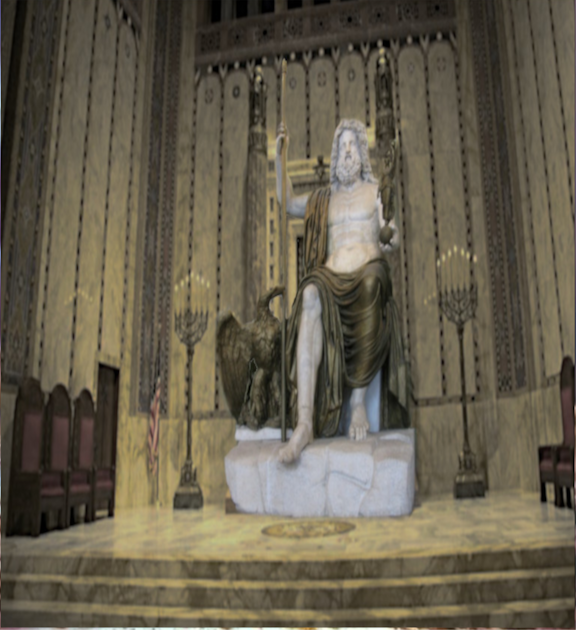
Now we come to what is easily the most familiar and controversial passage in Old Testament Bible prophecy, the Abomination of Desolation. As mentioned in the study of Jeremiah, Daniel understood from his writings that the seventy-year captivity of Israel in Babylon was coming to an end, and you may want to look at the chart in Constable's Notes on this chapter for where this captivity fits in the timeline. But pay attention to the fact that Daniel interpreted Jeremiah’s prophecy literally, so we shouldn’t think that Daniel’s prophecies aren’t also to be taken literally, especially since history shows their literal, physical fulfillment thus far.
Daniel’s response to this understanding was to go to God in prayer, confessing the sins of his people. Shouldn’t we Christians do the same as we see that day approaching
? Instead, many show either apathy or hostility to the study of prophecy. But Daniel prays for God’s deliverance, even though he already knows it’s coming, because that’s how true servants of God behave.
As we see in verse 20, the answer was already on its way via Gabriel, who gives a short but massively important prophecy starting in verse 24. This is the famous Seventy Weeks Prophecy
, packed with significant details. Because of those details, we know in hindsight that the weeks
or sevens
refer to groups of years, such that seventy of them amount to a total of 490 years. These are divided into three groups, but notice first of all the purposes and people involved:
- to
your people
andyour holy city
- to end and atone for sin
- to begin eternal righteousness
- to seal up prophetic vision
- to anoint and dedicate
the Most Holy Place
”Your people” are Daniel’s people, the Hebrews. Your city
is Daniel’s and the Hebrews’ city, Jerusalem. The most holy place
is the Temple in Jerusalem. Eternal righteousness
and sealing up prophecy
refer to the end of all things in life as we’ve known it. So this is a very specific prophecy for the people and land of Israel, and only involves us as Christians insofar as it involves the righteous of all ages.
In verse 25 we’re given a starting point: the command to restore and rebuild the literal, physical city of Jerusalem. We know this because it happened in history that way. Various such commands are discussed in Constable's Notes, but one in particular gave permission to rebuild Jerusalem specifically, and the calculations include the key fact that prophetic years were of 360 days rather than our modern 365. So counting 69x7 (483) prophetic years from the decree of 444 b.c. gives us 476 of our years, and then we determine the year a.d. by subtracting the 444, bringing us to 32 a.d.. That’s the year Jesus was crucified or cut off
.
But what about the seven and sixty-two
for that first 69? It depends on how one understands the ancient languages here, and how it should be punctuated. You can check this discussion for some painstaking detail about all that, and for widely different views on what the verse actually says. But we should be able to point to something that happened 7x7 (49) years after the decree, and then count 62x7 (434) years from there to Jesus’ crucifixion. The part about it being built with plaza and moat but in distressful times
is the key; the rebuilding would begin first with the perimeter, and would only be completed in 49 years.
To say (as some do with meticulous arguments) that this prophecy cannot refer to Jesus, is to say that there was no significance of the fullness of time
for Jesus to come per Gal. 4:4, no reason for the people of Jesus’ day to have been looking for their redemption per Luke 2:38, and no explanation for why Simeon had been told in Luke 2:26 that he wouldn’t die until he had seen the Messiah. I’m more inclined to reject the Hebrew upon which the linguistic arguments are made against this being a Messianic prophecy, especially since the Greek isn’t nearly as ambiguous. The prophecy in Greek says something like this, as far as I can determine, though no two translations seem to agree:
And you shall know and perceive, from the giving of word to respond and rebuild Jerusalem until an anointed prince comes, there will be 7 sevens and 62 sevens. The wall and square will be rebuilt in difficult times [or when the time is exhausted
]. (26) After the 62 sevens, the anointed will be devastated for no valid reason. The coming leader will pollute the city and holy place, and they will be cut off as in a flood. Devastations will be ordered until war ends. (27) He will enforce a covenant with many for one seven, and halfway through it sacrifices and offerings will be terminated. There will be a very defiling desecration upon the temple, and there will be desolation until the completed time.
Needless to say, this passage is very controversial, but the whole of scripture must be considered in order to guide us when the ancient wording is in so much dispute. A consistent approach to Bible interpretation both allows and demands that this be taken as Messianic. And that all came from just verse 25.
Verse 26 is about an anointed one being cut off, which we recall was also spoken of in similar terms in Isaiah 53, a clearly Messianic passage. Then the city and temple/sanctuary would be destroyed by the people of the coming prince
. It’s unclear whether the demise to come quickly like a flood refers to the prince or to the city and sanctuary, but it could be both, and a similar expression was used in Isaiah 59:19. It’s the people of the prince who do the destruction, not the prince himself. The destruction of Jerusalem and the Temple took place in 70 a.d., 37-38 years after Jesus’ ascension. It came at the hands of the Roman general Titus, whose soldiers burned the temple and then took it apart piece by piece to get the melted gold. This is what Jesus spoke of in Mat. 24:2.
Now to verse 27. The he
points to the nearest person mentioned, which was the one who would destroy the temple. But Titus didn’t desecrate the temple or enforce any covenant. Some claim that he
is Jesus, who destroyed the temple and ended sacrifices in the middle of Passover week. Yet not only does this theory make the seventieth seven a week of days rather than years like the first 69, Jesus didn’t make any covenant with a seven-year limit. In fact, the New Covenant wasn’t enacted until his death, which would be the start rather than the midpoint. And the temple system kept going until 70 AD. Another theory claims that Jesus’ public ministry was ended after 3-1/2 half years, but not only is it impossible to prove that it lasted that precise length of time, once again he made no seven-year covenant when he was baptized by John.
But what does fit is a yet-future fulfillment, where someone in the manner of both Antiochus Epiphanes and Titus will come and do all these things. This also blends well with Mat. 24:15-16, where the people of Judea are to run when they see what happens to the temple, and Rev. 12:13-15, where Israel is taken to safety for 3-1/2 years. So here’s the gist of the prophecy:
- 483 years from the command to rebuild Jerusalem until Messiah is put to death
- Armies under the Roman general Titus destroy Jerusalem and the Temple
- War and disasters continue until the end
- The Beast will confirm a treaty with many for the final 7 years
- Midway through the 7 he will end Temple sacrifice and desecrate it
- The end decreed upon him will come
Daniel 10
Yet another prophetic vision is given here. Notice in verse 3 that Daniel had given up meat and wine for three weeks, which means the vegetarian diet he was on when he first came to Babylon was not his lifelong habit. He was shown a vision of a glowing being in white linen, resembling John’s description of Jesus in Revelation. But the context indicates this is an angel rather than Jesus.
Notice also in verse 12 that God came to him because he had humbled himself and sought understanding. We often miss out on God’s will for our lives because we won’t do either or both of those things. But who is the prince of the kingdom of Persia
in verse 13? To delay a heavenly angel requires another supernatural being, so we can deduce that the Prince of Persia was a fallen angel that ruled behind the human powers of the land. Its power was such that the archangel Michael had to come and help.
After giving Daniel the strength to even listen to the message, notice again in verse 20 that this angel wasn’t looking forward to the return trip, which somehow would also involve the being ruling over Greece. Verse 21 mentions a dependable book
, a likely reference to a book of prophetic decrees in heaven. The angel or prince
Michael is said to be your
prince, with your
being plural. This refers to Daniel’s people, Israel, but this does not mean Michael is the Messiah, as some false religions teach. The angel’s words about all this continue into the next chapter, which really should begin at verse 2.
Daniel 11
In hindsight we know this is past to us today, and it begins with what would happen in Persia’s near future to the time of Daniel. Three Persian kings would arise, and then a fourth who stirs up trouble against Greece. Yet another king would arise, and by description we can identify him as Alexander the Great. This is where we get more detail about all that, and it goes on for quite a while, so I’ll just try to summarize.
Ptolemy I was the king of the south. The daughter was actually the granddaughter Berenice, who was given in marriage to Antiochus II in a doomed plan to achieve political gains by intrigue and deception. After various raids and generations, this king of the south was Ptolemy IV and then Ptolemy V. The king of the north was Antiochus III, who as prophesied was utterly defeated in 217 b.c.. The details fit historical record as with the Ptolemies, right up to the contemptible person Antiochus Epiphanes. It is he who is believed to have engineered the murder of a prince of the covenant, Onias III, the high priest. The first chapter of the apocryphal book 1 Maccabees details his plundering of the temple and other acts of savagery.
Again, though these things were indeed fulfilled in the past, we can’t dogmatically state that no future fulfillments remain. But neither can we presume that these alliances and military campaigns will be repeated in the future. In all the details of the remaining prophecies given in Revelation, there is no mention of the kings of the north and south and details that would connect them to future events. So though a future fulfillment is possible, it seems unlikely.
Yet in verse 36 we read of the king who exalts himself, who has no regard for the gods of his ancestors or the desire of women. This means a god honored by women, not that this person will be a pervert, though that’s certainly possible. Neither will this be a Muslim, since by definition he’d have to honor their god. Instead, he’ll honor a god of fortresses, in whose name he attacks other fortresses, and he’ll give out conquered lands as prizes.
We might still tie him in with the preceding discussion of Antiochus Epiphanes and the kings of the north and south, but in verse 40 we see the phrase at the time of the end
, so there’s a shift in fulfillment here, and new details to follow have no historical precedent. A king of the north will attack this future king, and the attack is then joined by a king of the south with a huge multi-faceted force. But he still manages to attack the land of Israel, though the people now occupying the country of Jordan will escape the assault. Egypt and the countries on the south side of the Mediterranean will fall, but he’ll hear alarming reports from the east and north, so he’ll go off in a rage. However, as he camps between the Mediterranean and Dead Seas he’ll come to his end. Though the Beast will begin with the appearance of peace, per 8:25 and Rev. 6:2, we’ve seen that war will rage for most of its short reign.
Daniel 12
Ch. 12 starts again with at that time
, and again Michael is mentioned as the prince watching over Israel. This is where we see the phrase Jesus used, a time of distress such as has not happened from the beginning of nations until then
. There has been much terrible suffering in the world since 70 a.d., such that the fall of Jerusalem at that time cannot have been the ultimate fulfillment of the prophecy.
Now because of this overlap and duality, teachers of Bible prophecy must exercise restraint and caution in looking for modern fulfillments. All we can be sure of is that those things without any historical match will certainly take place. And what it tells us here is that Daniel’s people, at least the ones whose names are in the book
, will escape. We know that whoever sees the Abomination of Desolation and runs will be kept safe during the Great Tribulation, the final 3-1/2 years.
Then we see the first clear Old Testament statement about eternity: Some will arise to experience everlasting life, but others to experience everlasting contempt. The contrast is not between existence and non-existence, or long and short existence since both are everlasting, but honor and shame. Now in verse 4 Daniel is told again to seal the prophecy, but in this case, until the time of the end
. This is why Revelation, which means the opposite, is a book for the time of the end, not the past. But what does it mean that people will run around and increase knowledge? The two together suggest a desperate thirst for understanding, though it could also be a clue about modern life. All we know is that the reign of the Beast is for a mere 3-1/2 years.
We should take comfort in knowing that not even Daniel could figure this out, but we aren’t to know the timing until the fulfillment begins. The angel repeats that there will be 3-1/2 years from the Abomination of Desolation and the end of the Tribulation, but adds that there’s a special blessing for whoever waits patiently for another 45 days after that. I was unable to find any consistent explanations for the extra days, though some think it might be a time of purification or reconstruction between Jesus’ defeat of the Beast and his entering Jerusalem.
Daniel’s book is short, but that’s a good thing, because it’s jam-packed with prophecy.



